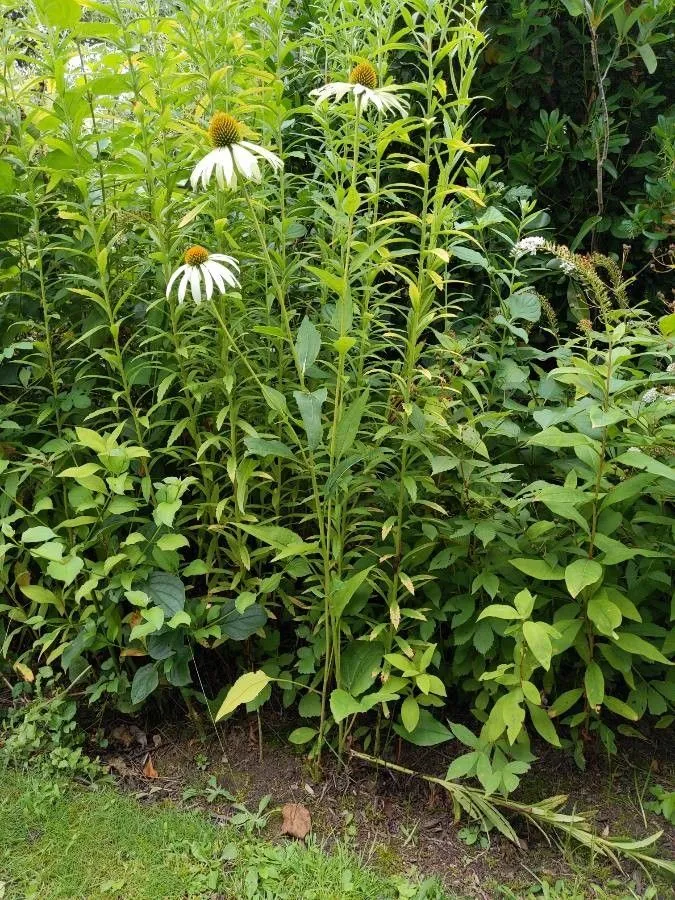
Author: (Nutt.) Nutt.
Bibliography: Trans. Amer. Philos. Soc., ser. 2, 7: 354 (1840)
Year: 1840
Status: accepted
Rank: species
Genus: Echinacea
Vegetable: False
Observations: E. Canada to C. & E. U.S.A.
Pale echinacea, scientifically known as Echinacea pallida, is a distinguished member of the family Asteraceae. First described by Thomas Nuttall in 1840, as detailed in the Transactions of the American Philosophical Society, this species has since garnered attention for its unique qualities and regional prevalence.
This remarkable perennial herb can be found thriving in substantial regions spanning from Eastern Canada down to the Central and Eastern United States. Ideal habitats for Pale echinacea include prairies, meadows, and open woodlands, where it can often be observed basking in full sunlight and thriving in well-drained soils.
The botanical structure of Echinacea pallida is characterized by its elongated, slender stems reaching heights of up to 90 centimeters. Its leaves are typically long and narrow, presenting a rough texture that complements the overall elegant appearance of the plant. One of the most striking features of Pale echinacea is its distinct flowering head. The drooping, pale pink to lavender petals surround a prominent cone-like center, which darkens as the plant matures, transitioning from a greenish hue to a rich brown. This conical center not only adds to the flower’s aesthetic appeal but also plays a crucial role in attracting pollinators such as bees and butterflies, which are essential for the propagation of the species.
Echinacea pallida holds not only ecological value but also cultural and medicinal significance. Historically, various Native American tribes utilized the roots and other parts of this plant for traditional medicine, particularly for its purported immune-boosting properties. Today, while more commonly known for its ornamental use in gardens and landscaped areas, Pale echinacea remains a subject of interest in the field of herbal medicine and holistic health practices.
This plant’s resilience and adaptability make it a beloved choice among garden enthusiasts seeking to add a touch of natural beauty and biological diversity to their outdoor spaces. By incorporating Pale echinacea into gardens, enthusiasts can enjoy not only the visual beauty of the plant but also contribute to the local ecosystem by supporting pollinator populations.
In summary, Pale echinacea (Echinacea pallida) stands out as a botanical gem with significant historical, ecological, and ornamental value. Its presence across various North American regions underscores its adaptability and robust nature, making it a symbol of the enduring beauty and complexity of native flora.
Swe: läkerudbeckia, blek solhatt
Eng: pale echinacea, pale purple coneflower, pale purple-coneflower, pale-flower echinacea, pale purple cone-flower, pale coneflower
Fra: échinacée pâle
En: Pale echinacea, Pale purple-coneflower, Pale-flower echinacea, Pale purple coneflower, Pale purple cone-flower, Pale coneflower
Ar: قنفذية شاحبة
Fi: Rohtopäivänhattu
Fr: Échinacée pâle
De: Prärie-Igelkopf
Hu: Halvány kasvirág
Fa: سر خار گل
Pt: Equinacea palida purpurea
Sv: Läkerudbeckia, Blek solhatt
Taken Aug 26, 2019 by Carlos Morate (cc-by-sa)
Taken Jul 26, 2019 by Beimers Heather (cc-by-sa)
Taken Jul 28, 2019 by Diane Martino (cc-by-sa)
Taken Jul 22, 2021 by Laurie Bruner (cc-by-sa)
Taken Aug 9, 2017 by Tiff DiFranco (cc-by-sa)
Taken Dec 5, 2021 by Patrick Guinn (cc-by-sa)
Taken Jul 19, 2019 by Ian Young (cc-by-sa)
Taken Jun 1, 2022 by ellie alvarado (cc-by-sa)
Taken Sep 27, 2021 by Jacques Zuber (cc-by-sa)
Taken Mar 13, 2020 by Catherine Mason (cc-by-sa)
Taken Jul 1, 2013 by EOL − Victor W Fazio III (cc-by-nc)
Taken Jun 3, 2015 by EOL − claireellwanger (cc-by-nc)
Taken Aug 19, 2021 by Nicolas Remeur (cc-by-sa)
Taken Jun 8, 2020 by Aaron Harp (cc-by-sa)
Taken Sep 11, 2022 by Annemarie Ahrens-Stehle (cc-by-sa)
Taken Sep 27, 2021 by Jacques Zuber (cc-by-sa)
Taken Sep 16, 2022 by Caw Vus (cc-by-sa)
Taken Jun 4, 2020 by Donald Awbrey (cc-by-sa)
Taken Jul 7, 2021 by Bela Borbely (cc-by-sa)
Growth form>: Single Stem
Growth habit>: Forb/herb
Growth rate>: Moderate
Ph maximum: 7.2
Ph minimum: 6.5
Family: Myrtaceae Author: (F.Muell.) K.D.Hill & L.A.S.Johnson Bibliography: Telopea 6: 402 (1995) Year: 1995 Status:…
Family: Rubiaceae Author: Pierre ex A.Froehner Bibliography: Notizbl. Bot. Gart. Berlin-Dahlem 1: 237 (1897) Year:…
Family: Sapindaceae Author: Koidz. Bibliography: J. Coll. Sci. Imp. Univ. Tokyo 32(1): 38 (1911) Year:…
Family: Asteraceae Author: A.Gray Bibliography: Pacif. Railr. Rep.: 107 (1857) Year: 1857 Status: accepted Rank:…
Family: Fabaceae Author: Medik. Bibliography: Vorles. Churpfälz. Phys.-Ökon. Ges. 2: 398 (1787) Year: 1787 Status:…
Family: Aspleniaceae Author: (Cav.) Alston Bibliography: Bull. Misc. Inform. Kew 1932: 309 (1932) Year: 1932…